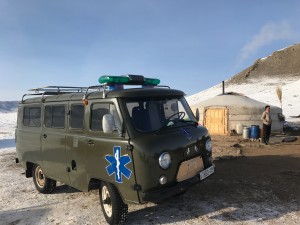While Queensland sweltered in a heat wave, Griffith University disaster expert Dr Hamish McLean tackled minus 30 degree temperatures in remote Mongolia to help the country’s health services.
Dr McLean, a senior lecturer in the School of Humanities, Languages and Social Science, joined Mongolian medics near the frozen Siberian border to see first-hand how the country was dealing with a declared winter disaster.
“The winter is particularly harsh this year which means local communities, and their livestock, can face extremely difficult freezing conditions — the reverse of Australia,” he said.
“While ambulance services in Australia were warning about dehydration, their counterparts in Mongolia were dealing with frostbite and hypothermia.”
Near the Siberian border, Dr McLean joined specialist medical teams transported to the ger (tent) homes of several nomadic families by old Russian ambulances (pictured below).
“Providing in-home specialist medical care helped overcome the lack of resources to get people in rural areas into hospitals,” he said.
The Mongolian Ministry of Health is now looking to improve communication with the public and between various agencies, particularly in times of disaster.
Dr McLean contributed several sessions on disaster communication and health leadership in disasters duringa two-day workshop in Januaryattended by more than 100 doctors and health officials from across the country’s 21 provinces. It attracted significant media interest with several television networks covering the event.
Mongolia has limited disaster response resources but has recognised that effective planning, coordination and communication between agencies and the public requires fewer resources and is achievable within a short time,” he said.
Dr McLean discussed best practices in disaster communication, information needed by the public and how to prepare provincial agencies for disasters with exercises and joint planning.
“Research shows that a key failure in disasters, no matter how prepared or resourced, is poor communication,”he said.
Health leadership
“Much of the focus in Mongolia is around health leadership — how the senior medical personnel can best lead their own teams, enhance situational awareness and rapid decision-making, and importantly, work closely with colleagues from other agencies, such as local government and police. It is all about the three ‘C’ approach: control, coordination and communication.
“In some provinces this has not happened to any extent, however the concept resonated with the participants.”
The Ministry of Health in Mongolia has made significant progress in emergency medical services in the capital city.
“The ambulance service in Ulaan Bataar has undergone significant improvement in the past five years with new vehicles, better equipment and more stations to decrease response times in critical cases,” he said.
“The rural areas are a different situation where old Russian jeeps,without stretchers, serve as ambulance vehicles. Equipment is limited and response times are significant given the terrain and long distances between limited medical facilities.”
Dr McLean was invited to Mongolia in recognition of Griffith University’s expanding footprint internationally in applied disaster research.
